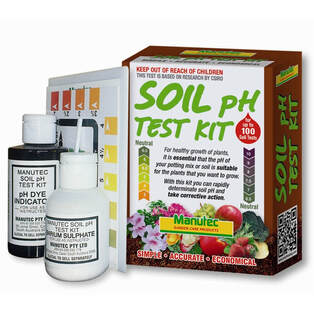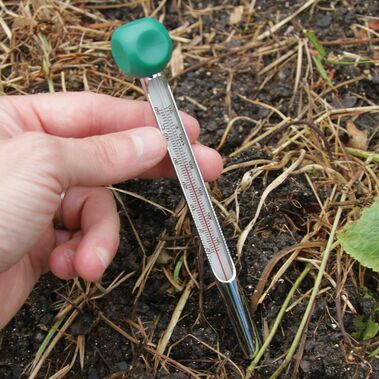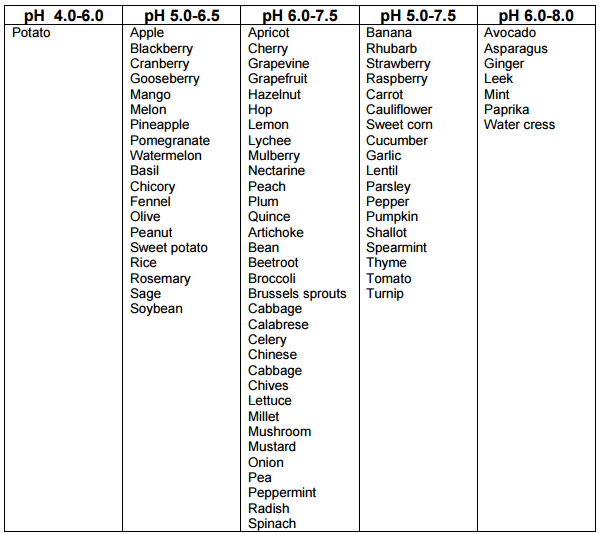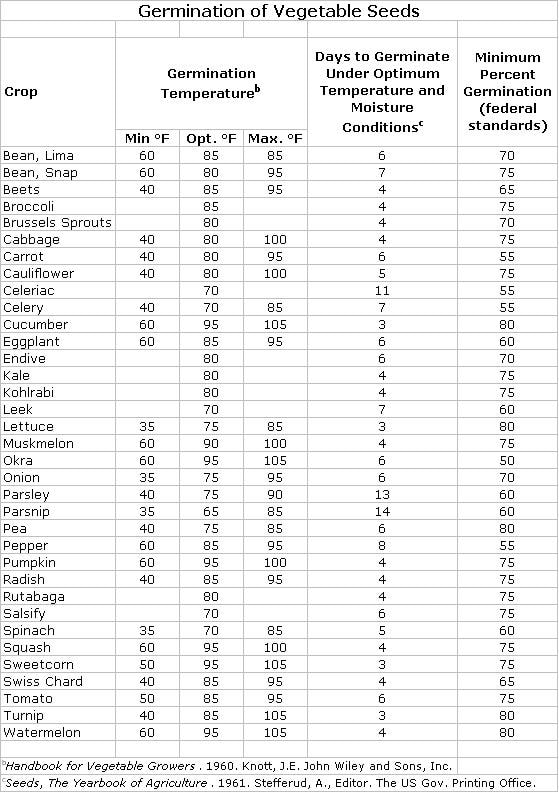Optimal Soil Conditions
What is pH?
pH is a scale of acidity from 0 to 14. It tells how acidic or alkaline a substance is. More acidic solutions have lower pH. More alkaline solutions have higher pH. Substances that aren't acidic or alkaline (that is, neutral solutions) usually have a pH of 7. Plants grow best when planted in soil tuned to their particular pH. See the chart below:
How do I know what my soil pH is?
 There are hundreds of options for pH testing kits out there starting at just a few dollars
There are hundreds of options for pH testing kits out there starting at just a few dollars
Any store that has a garden section will have soil testing kits. Some require a sample and others are like a digital thermometer you stick in the dirt. We're not doing any serious medical research here so whatever you can find should be just fine.
How can I change the pH of my soil?
First of all, these solutions are best applied in the fall so they have as long as possible to take effect. Depending on what you are trying to grow you may need to alter the pH of the existing soil significantly. Generally speaking though, almost all plants will thrive at a pH between 6-7.5. One great way to achieve this balance long term is to continuously replenish the soil with compost, which typically has a pH in this range itself.
How to increase pH
If you find you soil pH is lower than it should be, try adding limestone or wood ashes. You'll need to buy the limestone at a garden center or online but that will be more precise. The product instructions will tell you exactly how much to add per square foot to increase your pH level by 1. So if you're at a 4.5 and need to get to 6.5, this is probably the way to go. Wood ashes would best be used if you happen to have access to a lot of them for free and only need to raise the levels slightly.
How to decrease pH
If you find you soil pH is higher than it should be, what you do next depends on how much time you have. For a quick fix you can buy some products from the garden center. Powdered sulfur, aluminum sulfate, and iron sulfate work to raise the soil's pH level. The product instructions will tell you exactly how much to add per square foot to decrease your pH level by 1. Work with wood or know someone who does? Sawdust could be a free alternative to help raise pH - just make sure it's not pressure treated wood the sawdust came from.
The better long-term approach is to add particular organic materials that are naturally acidic. Pine needles, peat moss, and leaf mold (see Composting section for how to make leaf mold at home using all those leaves you rake up in the fall). We happen to live among a handful of large pine trees and use the needles that come down as mulch for our raspberries and blueberries. It gives an easy place to rake them over to and drops the soil down to the acidity the plants thrive in, eventually feeding the plants as they break down as well.
How to increase pH
If you find you soil pH is lower than it should be, try adding limestone or wood ashes. You'll need to buy the limestone at a garden center or online but that will be more precise. The product instructions will tell you exactly how much to add per square foot to increase your pH level by 1. So if you're at a 4.5 and need to get to 6.5, this is probably the way to go. Wood ashes would best be used if you happen to have access to a lot of them for free and only need to raise the levels slightly.
How to decrease pH
If you find you soil pH is higher than it should be, what you do next depends on how much time you have. For a quick fix you can buy some products from the garden center. Powdered sulfur, aluminum sulfate, and iron sulfate work to raise the soil's pH level. The product instructions will tell you exactly how much to add per square foot to decrease your pH level by 1. Work with wood or know someone who does? Sawdust could be a free alternative to help raise pH - just make sure it's not pressure treated wood the sawdust came from.
The better long-term approach is to add particular organic materials that are naturally acidic. Pine needles, peat moss, and leaf mold (see Composting section for how to make leaf mold at home using all those leaves you rake up in the fall). We happen to live among a handful of large pine trees and use the needles that come down as mulch for our raspberries and blueberries. It gives an easy place to rake them over to and drops the soil down to the acidity the plants thrive in, eventually feeding the plants as they break down as well.
Optimal Soil Temperature
Even if the pH is perfect, seeds will only germinate when the soil reaches a certain temperature. The chart below will break down the minimum, maximum, and optimal range for the most common vegetables you may be planting. If you don't see exactly what you are looking for, see the Plant Families chart and find a vegetable on this list that is in the same family as yours. Typically they will do well in similar conditions (For example see tomato, eggplant, and peppers below) .
How do I know what my soil temperature is?
 Bad news: You'll have to buy this. Good news: It won't have your kid's vomit on it
Bad news: You'll have to buy this. Good news: It won't have your kid's vomit on it
Any store that has a garden section will have a soil thermometer. I'm sure they have some real fancy ones, but again we're not getting ready to split any atoms so whatever you can find should be just fine.
This might sound dumb, but can I raise or lower the soil temperature?
Don't be so hard on yourself, you definitely can.
How to raise soil temperature
So you want to play God, do you? Believe us, we understand wanting to get started ASAP after a long winter. The cheapest option is probably plastic "mulch" which is really just sheets of plastic that cover the entire garden bed. Imagine wearing a black windbreaker vs. a white t-shirt on a warm sunny day - same principal applies here. If you have a little more money to spend you can invest in row covers, cold frames, or other mini-greenhouse type products designed to warm the soil and extend the growing season. So far we've gone with patience ourselves. Doesn't do anything to warm the soil but it is free.
How to decrease soil temperature
This most likely isn't an issue while trying to germinate seeds but may be during the dog days of summer. A thick layer of organic mulch such as grass clippings, straw, or wood chips will deflect the heat of the sun protecting the soil beneath. It will absorb the heat above while slowing evaporation below, maintaining moisture levels and helping to cool the soil. It's important to keep this in mind when planting heat loving plants such as squash and corn. We always apply a thick layer of mulch to suppress weeds but only after the seeds have all germinated and are well established, that way we're not slowing the warming of the soil in the already too-short growing season we have,
How to raise soil temperature
So you want to play God, do you? Believe us, we understand wanting to get started ASAP after a long winter. The cheapest option is probably plastic "mulch" which is really just sheets of plastic that cover the entire garden bed. Imagine wearing a black windbreaker vs. a white t-shirt on a warm sunny day - same principal applies here. If you have a little more money to spend you can invest in row covers, cold frames, or other mini-greenhouse type products designed to warm the soil and extend the growing season. So far we've gone with patience ourselves. Doesn't do anything to warm the soil but it is free.
How to decrease soil temperature
This most likely isn't an issue while trying to germinate seeds but may be during the dog days of summer. A thick layer of organic mulch such as grass clippings, straw, or wood chips will deflect the heat of the sun protecting the soil beneath. It will absorb the heat above while slowing evaporation below, maintaining moisture levels and helping to cool the soil. It's important to keep this in mind when planting heat loving plants such as squash and corn. We always apply a thick layer of mulch to suppress weeds but only after the seeds have all germinated and are well established, that way we're not slowing the warming of the soil in the already too-short growing season we have,

